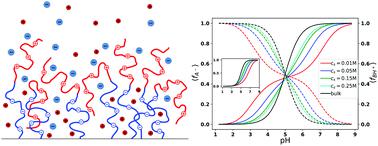当前位置:
X-MOL 学术
›
Soft Matter
›
论文详情
Our official English website, www.x-mol.net, welcomes your
feedback! (Note: you will need to create a separate account there.)
Charge regulation mechanism in end-tethered weak polyampholytes.
Soft Matter ( IF 2.9 ) Pub Date : 2020-09-01 , DOI: 10.1039/d0sm01323d D Prusty 1 , R J Nap 2 , I Szleifer 3 , M Olvera de la Cruz 4
Soft Matter ( IF 2.9 ) Pub Date : 2020-09-01 , DOI: 10.1039/d0sm01323d D Prusty 1 , R J Nap 2 , I Szleifer 3 , M Olvera de la Cruz 4
Affiliation

|
Weak polyampholytes, containing oppositely charged dissociable groups, are expected to be responsive to changes in ionic conditions. Here, we determine structural and thermodynamic properties, including the charged groups’ degrees of dissociation, of end-tethered weak polyampholyte layers as a function of salt concentration, pH, and the solvent quality. For diblock weak polyampholytes grafted by their acidic blocks, we find that the acidic monomers increase their charge while the basic monomers decrease their charge with decreasing salt concentration for pH values less than the pKa value of both monomers and vice versa when the pH > pKa. This complex charge regulation occurs because the electrostatic attraction between oppositely charged blocks is stronger than the repulsion between monomers with the same charge in both good and poor solvents when the screening by salt ions is weak. This is evidenced by the retraction of the top block into the bottom layer. In the case of poor solvent conditions to the basic block (the top block), we find lateral segregation of basic monomers into micelles, forming a two-dimensional hexagonal pattern on the surface at intermediate and high pH values for monovalent salt concentrations from 0.01 to 0.1 M. When the solvent is poor to both blocks, we find lateral segregation of the grafted acidic block into lamellae with longitudinal undulations of low and high acidic monomer density. By exploiting weak block polyampholytes, our work expands the parameter space for creating responsive surfaces stable over a wide range of pH and salt concentration.
中文翻译:

末端束缚的弱两性电解质中的电荷调节机制。
包含相反电荷的可解离基团的弱两性电解质有望响应离子条件的变化。在此,我们确定了末端束缚的弱两性电解质层的结构和热力学性质(包括带电基团的解离度)与盐浓度,pH和溶剂质量的关系。对于用酸性嵌段接枝的二嵌段弱两性电解质,我们发现,当pH值小于两个单体的p K a值时,酸性单体会增加电荷,而盐浓度降低时碱性单体会降低电荷,反之,当pH> p ķ一。之所以发生这种复杂的电荷调节,是因为当盐离子的筛选较弱时,带相反电荷的嵌段之间的静电吸引力要强于在良好溶剂和不良溶剂中具有相同电荷的单体之间的排斥力。这可以通过顶层砖缩入底层来证明。在碱性嵌段(顶部嵌段)的溶剂条件较差的情况下,我们发现碱性单体的横向偏析成胶束,在中等和高pH值(0.01至0.01的单价盐浓度)下,在表面上形成二维六角形图案0.1M。当两种嵌段的溶剂均较差时,我们发现接枝的酸性嵌段在侧向偏析成薄片,纵向和纵向波动的酸性单体密度低而低。通过利用弱嵌段多两性电解质,
更新日期:2020-10-07
中文翻译:

末端束缚的弱两性电解质中的电荷调节机制。
包含相反电荷的可解离基团的弱两性电解质有望响应离子条件的变化。在此,我们确定了末端束缚的弱两性电解质层的结构和热力学性质(包括带电基团的解离度)与盐浓度,pH和溶剂质量的关系。对于用酸性嵌段接枝的二嵌段弱两性电解质,我们发现,当pH值小于两个单体的p K a值时,酸性单体会增加电荷,而盐浓度降低时碱性单体会降低电荷,反之,当pH> p ķ一。之所以发生这种复杂的电荷调节,是因为当盐离子的筛选较弱时,带相反电荷的嵌段之间的静电吸引力要强于在良好溶剂和不良溶剂中具有相同电荷的单体之间的排斥力。这可以通过顶层砖缩入底层来证明。在碱性嵌段(顶部嵌段)的溶剂条件较差的情况下,我们发现碱性单体的横向偏析成胶束,在中等和高pH值(0.01至0.01的单价盐浓度)下,在表面上形成二维六角形图案0.1M。当两种嵌段的溶剂均较差时,我们发现接枝的酸性嵌段在侧向偏析成薄片,纵向和纵向波动的酸性单体密度低而低。通过利用弱嵌段多两性电解质,









































 京公网安备 11010802027423号
京公网安备 11010802027423号